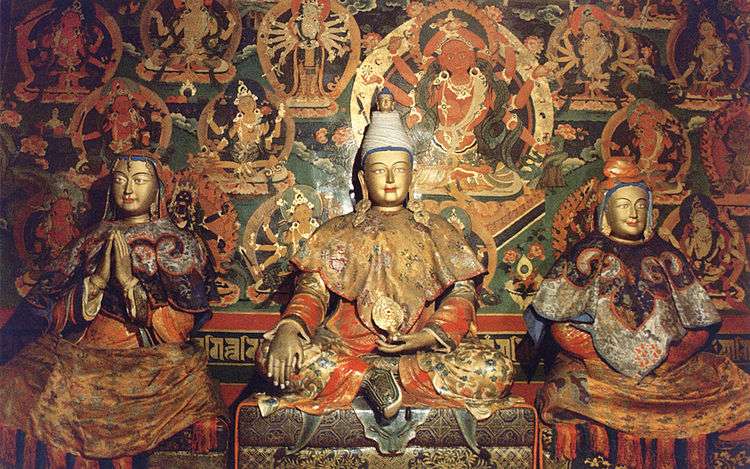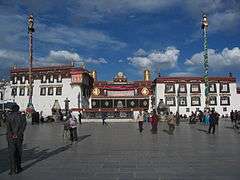Princess Wencheng
Princess Wencheng (Tibetan: Mung-chang Kungco; Chinese: 文成公主; pinyin: Wénchéng Gōngzhǔ; Wade–Giles: Wen-ch'eng Kung-chu; 620s – 680/2[1][2]), surnamed Li, was a member of a minor branch of the royal clan of the Chinese Tang dynasty. In 641,[2] she was granted by Emperor Taizong of Tang to King Songtsän Gampo of Tibet for marriage, an involuntary actor of the emperor's heqin (marriage alliance) policy.[3] She is popularly known in Tibet as Gyasa, or "Chinese wife".[4]
| Princess Wencheng | |
|---|---|
 | |
| Born | 620s |
| Died | 680 or 682 Lhasa |
| Husband | Songtsen Gampo |
| Religion | Buddhism |
Much of her life has been mythified and used for propaganda purposes. Chinese sources since the Tang dynasty credit her with introducing Chinese culture to Tibet,[5] whereas Tibetan sources credit her, along with Songtsän Gampo's Nepalese wife, Bhrikuti, with introducing Buddhism to Tibet.[6][7] Traditional Tibetan histories consider both Wencheng and Bhrikuti as physical manifestations of the bodhisattva Tara,[8] although the historical veracity of Bhrikuti is still debated among scholars.[2][9]
Life
Princess Wencheng was born in the 620s, the exact year uncertain. She was a member of the imperial clan of the Tang dynasty. Her surname was Li, but her given name was not recorded in history.[1]
In the 630s, Tibet was a rising military power in Asia, while the newly established Tang dynasty of China was trying to secure its western borders with the restive Tuyuhun (Azha) Kingdom.[10] In 634, King Songtsen Gampo of the Tibetan Yarlung dynasty sent an ambassador to the court of Emperor Taizong of Tang.[10] Four years later, Songtsen sent his prime minister, Gar Tongtsen, to the Tang court to request a marriage alliance. While Taizong was considering his request, a Tuyuhun prince also arrived at Chang'an and made the same request. As Tibet was an obscure and distant kingdom to the Tang, Taizong granted the princess to Tuyuhun and sent Gar home empty-handed.[10]
Offended by the rejection, Songtsen sent his army, together with his Zhangzhung allies, to attack Tuyuhun. Tuyuhun was quickly defeated and incorporated into the Tibetan Empire, later known as the province of Amdo.[10] With his army now stationed at China's border, Songtsen demanded the princess for marriage. Taizong again rejected the request and dispatched an army to attack the Tibetans, but was defeated.[10] In 641, Songtsen sent Gar to Chang'an again bearing gifts.[11] This time Taizong not only agreed to give Wencheng to Songtsen in marriage, he also granted another princess to be Gar's wife.[12]
In 641, Princess Wencheng, then very young,[1] was escorted to Tibet by Gar, with a large entourage. Her marriage with Songtsen ushered in two decades of peace and cultural exchange, during which Tibetan aristocrats went to Chang'an to study in its schools, and Chinese craftsmen brought technologies such as paper making to Tibet.[13][14]
After Songtsen Gampo died in 650, Wencheng lived as a widow in Tibet for another 30 years until her death, and never returned to China. Although she did not seem to have played a major role in Tibetan politics, she likely strengthened Buddhism by supporting pilgrims such as Xuanzang.[14] She supported Tibet's request for another marriage alliance for Songtsen's successor, but it was not granted until decades after her death, when Princess Jincheng was married to Me Agtsom.[14]
Legacy
Princess Wencheng’s life is depicted in novels such as the Maṇi bka' 'bum and the famed historiographies of Rgyal rabs Gsal ba'i Me long.
Tradruk Temple in Nêdong commemorates Princess Wencheng: a thangka embroidered by the Princess is kept in one of its chapels.
Two traditional days, the fifteenth day of the fourth month and the fifteenth day of the tenth month of each Tibetan year, are marked by singing and dancing in honor of Princess Wencheng.
Historical relics such as the statues of Songtsen Gampo with Princess Wencheng are still worshiped and displayed for all to see along the trail of their wedding trip as well as in the Potala Palace at Lhasa.[1]
In propaganda
Princess Wencheng is used as a political tool to justify the Sinicization of Tibet in the People's Republic of China. Claims about Princess Wencheng generally credit her with bringing civilization to Tibet.[5]
Since the 2000s, the Chinese state has been presenting an historical drama in Tibet which outlines the history of Tibet and especially the history of Chinese influence in the region. The drama seems to focus on the life and legacy of Princess Wencheng, depicting her relationship with King Songtsen Gampo and all of the cultural influences which she had on Tibet.[15]
Footnotes
- Jay (2014), p. 205.
- Warner (2011), p. 6.
- Slobodník (2006), p. 268.
- Dowman (1988), p. 41.
- Powers (2004), p. 32.
- Laird (2007), p. 35.
- Powers (2004), p. 35.
- Powers (2004), p. 36.
- Powers (2004), p. 170.
- Van Schaik (2011), p. 7.
- Van Schaik (2011), p. 8.
- Van Schaik (2011), p. 9.
- Van Schaik (2011), p. 10.
- Jay (2014), p. 204.
- Denyer, Simon (2016). "A romantic opera in Tibet just happens to bolster China's historical position there". The Washington Post.
References and further reading
- Beckwith, Christopher I. (1987). The Tibetan Empire in Central Asia. Princeton: Princeton University Press.CS1 maint: ref=harv (link)
- Dowman, Keith (1988). The Power-places of Central Tibet: The Pilgrim's Guide. London and New York: Routledge & Kegan Paul. ISBN 0-7102-1370-0.CS1 maint: ref=harv (link)
- Jay, Jennifer W. (2014). "Li, Princess Wencheng". In Lee, Lily Xiao Hong; Wiles, Sue (eds.). Biographical Dictionary of Chinese Women: Tang Through Ming, 618–1644. M.E. Sharpe. pp. 204–205. ISBN 978-0-7656-4316-2.CS1 maint: ref=harv (link)
- Laird, Thomas (2007). The Story of Tibet: Conversations with the Dalai Lama. Grove Press. ISBN 978-0-8021-4327-3.CS1 maint: ref=harv (link)
- Peterson, Barbara Bennett (2000). Notable Women of China. M.E. Sharpe. ISBN 978-0-7656-1929-7.CS1 maint: ref=harv (link)
- Powers, John (2004). History As Propaganda : Tibetan Exiles versus the People's Republic of China: Tibetan Exiles versus the People's Republic of China. Oxford University Press. ISBN 978-0-19-803884-9.CS1 maint: ref=harv (link)
- Richardson, Hugh E. (1965). "How Old was Srong Brtsan Sgampo" (PDF). Bulletin of Tibetology. 1 (2): 5–9.CS1 maint: ref=harv (link)
- —— (1997). "Mun Sheng Kong Co and Kim Sheng Kong Co: Two Chinese Princesses in Tibet". The Tibet Journal. 22 (1): 3–11.CS1 maint: ref=harv (link)
- Slobodník, Martin (2006). "The Chinese Princess Wencheng in Tibet: A Cultural Intermediary between Facts and Myth". In Gálik, M.; Štefanovičová, T. (eds.). Trade, Journeys, Inner- and Intercultural Communication in East and West (up to 1250). Bratislava: Lufema. pp. 267–276.CS1 maint: ref=harv (link)
- Van Schaik, Sam (2011). Tibet: A History. Yale University Press. ISBN 978-0-300-17217-1.CS1 maint: ref=harv (link)
- Warner, Cameron David (2011). "A Prolegomenon to the Palladium of Tibet, the Jowo (Jo bo) Śākyamuni". In Bue, Erberto Lo (ed.). Proceedings of the Tenth Seminar of the IATS, 2003. Volume 13: Art in Tibet: Issues in Traditional Tibetan Art from the Seventh to the Twentieth Century. BRILL. pp. 3–17. ISBN 90-04-15519-8.CS1 maint: ref=harv (link)
